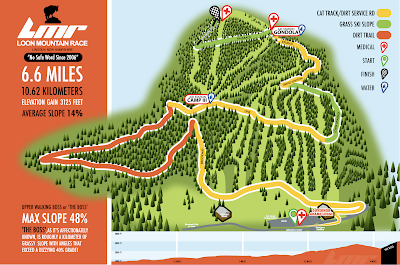 |
| 2018 US Mnt Running Champion Allie McLaughlin on UWB Photo: Joe Viger Photography |
At first glance the Loon Mountain Race looks pretty straightforward. Start at the bottom of the mountain and race to the top. Yet, as with most things, the devil is in the details. Because this is not your ordinary 6.6 mile race and the terrain varies, it's important to have an understanding of the course. In an effort to mentally compartmentalize the race and develop specific training strategies the following is a break down of the course.
General Overview
Distance: 6.6 miles
Elevation Gain: 3125 feet
Average Slope: 14%
Surfaces: dirt service roads, ski slopes, and dirt trails
 |
Course Map The course map provides a general overview of the various surfaces participants will encounter. |
With a challenge such as the Loon Mountain Race it's helpful to break the course down into manageable 'sections' and 'climbs'. Described below is the course in three sections with five (5) distinct 'climbs' and some insider knowledge from legendary mountain runner Dave Dunham. Each section also includes a sample indoor workout for those folks who do not have access to mountainous terrain. As with any exercise program you must be of good health and make initial modifications if necessary.
Section 1: Start to Camp III Aid Station
Climb #1: Brookway
Mile 0.9 -> 1.4
Distance: 0.5 miles
Approximate Average Grade: 12%
Surface: Gravel Access Road
Climb #2: Nordic
Mile 1.9 -> 2.3
Distance: 0.4 miles
Approximate Average Grade: 15% (but that's early, it's steep early and then "flattens" out)
Surface: Dirt/Mud Singletrack
Insider Knowledge: Starts near the river (927’) wide dirt parking lot narrows to dirt road (no need to panic, plenty of time and space to pass…some will go out as if it were the start of a 5k XC race, they will pay for it later).
At 0.2 there is 150 meters of paved road as you navigate a couple of tight turns around the buildings (keep your head up and cut those tangents). From 0.3 to 0.7 climb 200’ on cat track. 0
.3 on cat track drops 100’ bringing you to the mile (1,060’).
Section 1 Treadmill Workout
Warm-Up: 1 mile @ 3%
1/2 mile @ 12% (Brookway)
1/2 mile @ 5%
1/2 mile @ 10% (Nordic)
Cool-down: 1/2 mile @ 3%
NOTE: Run slowly if you can but walk if you must.
Section 2: Camp III Aid Station to Gondola Aid Station
Climb #3: Lower Speakeasy
Mile 4.1 -> 4.5
Distance: 0.4 miles
Approximate Average Grade: 18%
Surface: Grass
Insider Knowledge: At an average grade of 18% and all on grass, this is a great test, many will start walking here.
Climb #4: Upper Bear Claw
Mile 4.8 -> 5.6
Distance: 0.8 miles
Approximate Average Grade: 16% (there are short sections here that are 30%+)
Surface: Gravel Access Road
Insider Knowledge: This one gets steeper as you climb and can be hot with no shade.
Section 2 Treadmill Workout
Warm-Up: 1 mile @ 3%
1/2 mile @ 15% (Lower Speakeasy)
1/2 mile @ 7%
1/2 mile @ 15% (Upper Bear Claw)
Cool-down: 1/2 mile @ 3%
NOTE: Most widely accessible commercial treadmills will only go to 15% elevation. This workout is almost certainly at a walking pace.
Section 3: Gondola Aid Station to Finish (North Peak Summit)
Climb #5: Upper Walking Boss
Mile 6.1 -> 6.6
Distance: 0.5 miles
Approximate Average Grade: 40%
Surface: Grass
Insider Knowledge: No breaks, brutal climb.
Upper Walking Boss
The first hand accounts of Upper Walking Boss from some of the most talented mountain runners in the United States tells you everything you need to know about this section of the course.
When it comes to preparing for Upper Walking Boss there just isn't an easy way to do it. While specialized "incline trainers" do exist and go to 40% grade, very few people have access to them. Similarly, not many will have ski slopes nearby and most of them are covered in snow during the winter months. However, there is a reasonable substitute that is available to many folks and is a terrific indoor option...the stepmill. This device approximately simulates a 55% grade which is actually steeper than the steepest sections of Upper Walking Boss. The following stepmill-specific workout is best performed at the end of either a strength training or a cardiovascular training unit.
Section 3 Stepmill Workout
Warm-Up: 5 minutes (Level 1)
Estimated Upper Walking Boss time* (Level 4+)
Cool-down: 5 minutes (Level 1)
*Estimating Upper Walking Boss Time
In 2018 the median segment time on Upper Walking Boss (UWB) was 15:56. You can estimate your UWB time by evaluating your general finish place in an uphill-specific mountain race (ideally) or local road race. If you tend to finish in the back half of the field then aim for a UWB-specific workout time of slightly greater than 15 minutes. If you tend to finish in the front half of the field then aim for a UWB-specific workout time of slightly less than 15 minutes. Just keep in mind that the fastest splits on UWB in 2018 were Joe Gray (7:09) and Allie McLaughlin (8:20).
Pro-Tip: When performing this stepmill-specific workout make every attempt to not hold onto the handrails. By remaining 'hands free' you can achieve a heart rate of 10-15 beats/minute higher at any level than when holding on. This may be the difference between two different training zones (ie. Zone 2: Endurance vs. Zone 3: Tempo).
Any of these Loon Mountain Race-specific workouts shouldn't be performed more than twice a week. And for most folks, once a week at this time of year is perfect. As the snow recedes in certain places in the United States these strength endurance workouts will be brought outside.





